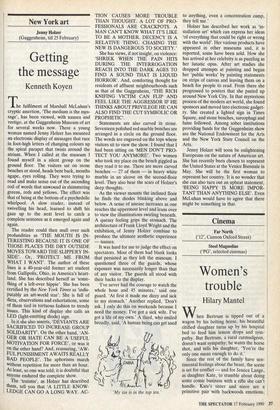New York art
Jenny Holzer (Guggenheim, till 25 February)
Getting the message
Kenneth Koyen
The fulfilment of Marshall McLuhan's cryptic assertion, 'The medium is the mes- sage', has been viewed, with nausea and vertigo, at the Guggenheim Museum of art for several weeks now. There a young woman named Jenny Holzer has mounted an electronic display of messages that race in foot-high letters of changing colours up the spiral parapet that twists around the atrium. When I called at the museum I found myself in a silent group on the ground floor. The visitors sat on stone benches or stood, heads bent back, mouths agape, eyes rolling. They were trying to read and make sense out of the ascending coil of words that unwound in shimmering greens, reds and yellows. The effect was that of being at the bottom of a psychedelic whirlpool. A slow reader, instead of swivelling his head, learned to shift his gaze up to the next level to catch a complete sentence as it emerged again and again.
The reader could then mull over such profundities as "THE MOUTH IS IN- TERESTING BECAUSE IT IS ONE OF THOSE PLACES THE DRY OUTSIDE MOVES TOWARD THE SLIPPERY IN- SIDE'. Or, 'PROTECT ME FROM WHAT I WANT'. The author of these lines is a 40-year-old former art student from Gallipolis, Ohio, in America's heart- land. She has described herself as 'some- thing of a left-over hippie'. She has been certified by the New York Times as 'indis- putably an art-world star'. She is full of dicta, observations and exhortations, some of them tied in tortuous fashion to trendy issues. This kind of display she calls an LED (light-emitting diode) sign.
In it she also asserts, 'DEVIANTS ARE SACRIFICED TO INCREASE GROUP SOLIDARITY'. On the other hand, 'AN- GER OR HATE CAN BE A USEFUL MOTIVATION FOR FORCE', or was it on the other hand? And, reassuring, 'AW- FUL PUNISHMENT AWAITS REALLY BAD PEOPLE'. The aphorisms march Without repetition for more than an hour. At least, so one was told; it is doubtful that anyone endured the complete show.
The 'truisms', as Holzer has described them, tell you that 'A LITTLE KNOW- LEDGE CAN GO A LONG WAY. AC- TION CAUSES MORE TROUBLE THAN THOUGHT. A LOT OF PRO- FESSIONALS ARE CRACKPOTS. A MAN CAN'T KNOW WHAT IT'S LIKE TO BE A MOTHER. DECENCY IS A RELATIVE THING. CHASING THE NEW IS DANGEROUS TO SOCIETY.'
She has views, if not insight, on violence: 'SHRIEK WHEN THE PAIN HITS DURING THE INTERROGATION REACH INTO THE DARK AGES TO FIND A SOUND THAT IS LIQUID HORROR'. And, comforting thought for residents of affluent neighbourhoods such as that of the Guggenheim, `THE RICH KNIFING VICTIM CAN FLIP AND FEEL LIKE THE AGGRESSOR IF HE THINKS ABOUT PRIVILEGE HE CAN ALSO FIND THE CUT SYMBOLIC OR PROPHETIC'.
Statements are also carved in stone. Seventeen polished red marble benches are arranged in a circle on the ground floor. The words are engraved on the tops where visitors sit to view the show. I found that I had been sitting on 'MEN DON'T PRO- TECT YOU ANYMORE'. Two women who took my place on the bench giggled as they read it to me. There are more carved benches —27 of them — in heavy white marble in an alcove on the second-floor level. They also bear the scars of Holzer's deep thoughts.
As the viewer mounts the inclined floor he finds the diodes blinking above and below. A sense of unease increases as one reaches the uppermost level and leans over to view the illuminations swirling beneath. A queasy feeling grips the stomach. The architecture of Frank Lloyd Wright and the exhibition, of Jenny Holzer combine to produce the ultimate aesthetic experience — nausea.
It was hard for me to judge the effect on spectators. Most of them had blank looks that persisted as they left the museum. I questioned three of the guards, whose exposure was necessarily longer than that of any visitor. The guards all stood with their backs to the display.
'I've never had the courage to watch the whole hour and 45 minutes,' said one guard. 'At first it made me dizzy and sick to my stomach.' Another replied, 'Don't ask. I only do this on weekends because I need the money. I've got a sick wife. I've got a life of my own.' A third, who smiled broadly, said, 'A human being can get used `Aly sin is in the top ten.' to anything, even a concentration camp, they tell me.'
Holzer has described her work as 'in- stallation art' which can express her ideas 'of everything that could be right or wrong with the world'. Her various products have appeared in other museums and, it is reported, some have been sold. How she has arrived at her celebrity is as puzzling as her lunatic opus. After art studies she dropped attempts at painting and began her 'public works' by painting statements on strips of canvas and leaving them on a beach for people to read. From there she progressed to posters that she pasted up around New York City. In that mysterious process of the modern art world, she found sponsors and moved into electronic gadget- ry. She created a lighted sign in Times Square, and stone benches, sarcophagi and fame followed. Among sober institutions providing funds for the Guggenheim show are the National Endowinent for the Arts and the New York State Council on the Arts.
Jenny Holzer will soon be enlightening Europeans on the nature of American art. She has recently been chosen to represent the United States at the Venice Biennale in May. She will be the first woman to represent her country. It is no wonder that she can also turn out an upbeat statement, 'BEING HAPPY IS MORE IMPOR- TANT THAN ANYTHING ELSE'. Even McLuhan would have to agree that there might be something in that.


















































 Previous page
Previous page